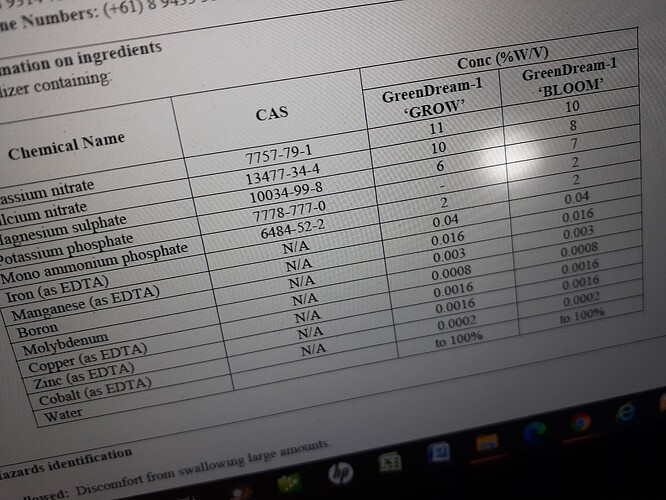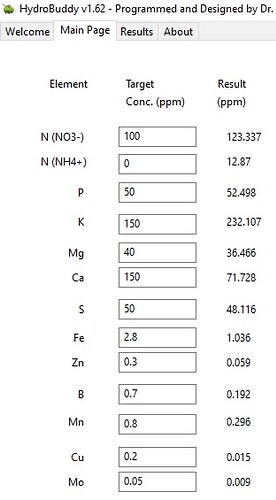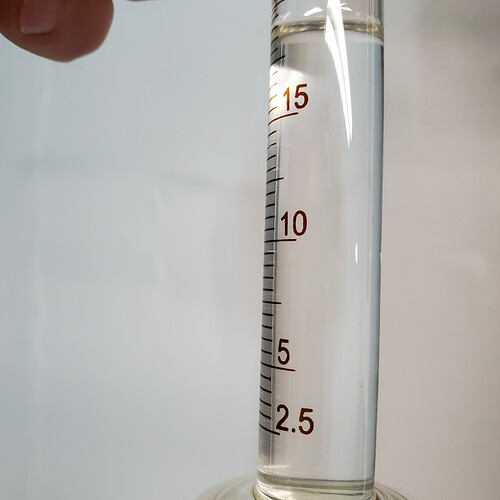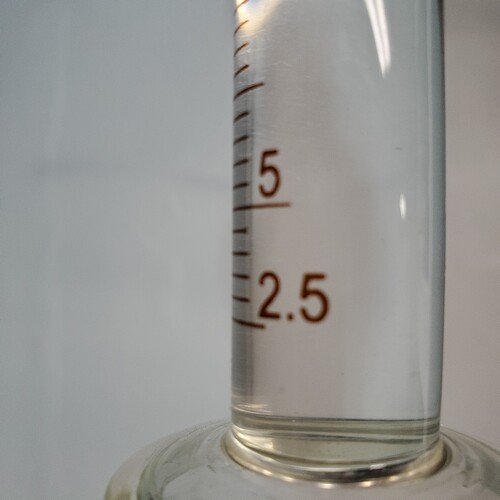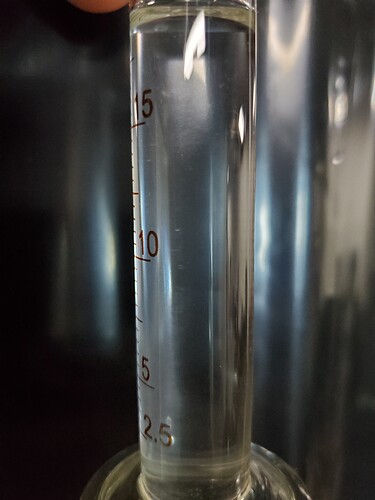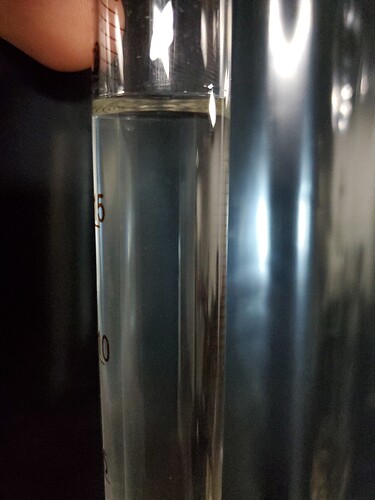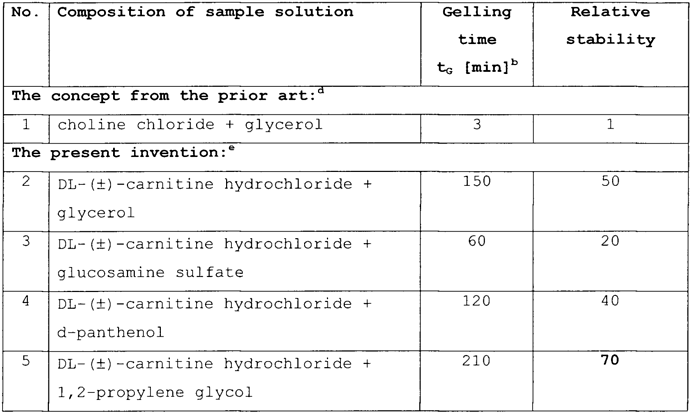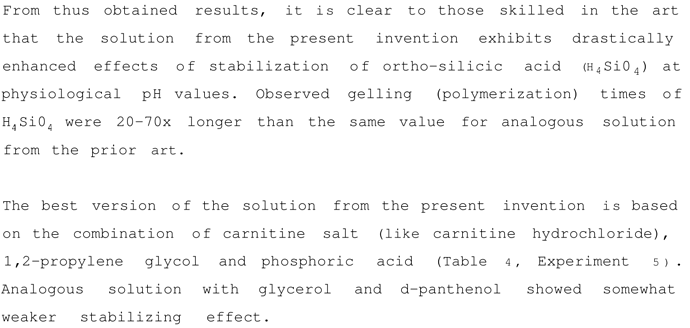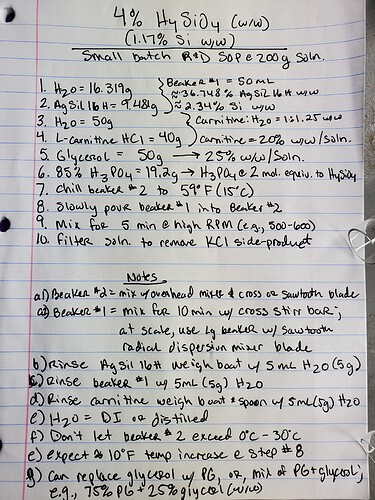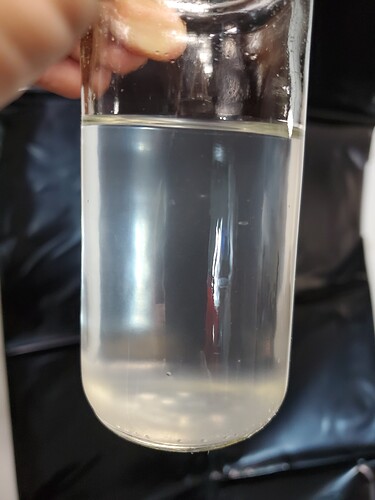Even cooler. In the early 2000s we were pulling 2.2lbs per 1000w back then. You’re gonna tell me you did btr blah blah etc. Sure. Maximum yield urly conventions and those apart of it were the ones topping out yield sizes in USA. But you’ll tell me different. I seen Flairform compared to 10 other brands of that time including advanced etc. Ull tell me you were running 20 1000w back then too. Yep
Or did we just have a great indoor system that handled the work and it wasn’t the nutes. You tell me. Only started seeing similar grow environments in the last 5 yrs.
Actually it has calcium nitrate and mag sulphate in the 1 part. I could email you the Msds sheet ![]() . Thanks for letting me know about my cool story and telling me. Inbox me your email if you want to see the Msds. Again not here to argue with the experts from the 2020s pop culture weed times.
. Thanks for letting me know about my cool story and telling me. Inbox me your email if you want to see the Msds. Again not here to argue with the experts from the 2020s pop culture weed times.
What a weird assumption. I take a lot of pride in being open and honest with people here about growing and what I have done over the last 25 years.
If you want my personal phone number to chat about it in person, hit up my DM’s.
You are correct on the SilikaMajic just potassium silicate and water on the msds
FYI @lexur5139, @AgTonik ALWAYS comes correct.
Not on the Green Dream 1 part. Read above. 1 part does have things that were said mentioned.
Take a picture of the label for me. I’ll take the time to plug it into Hydrobuddy and show you how low the calcium and magnesium content is.
In a 1-part fertilizer, it has to stay low to prevent making calcium sulfate precipitation in the bottle.
Flairform Flower 1-part:
Good: 10:1 NO3-:NH4+ nitrate sources to keep pH stable
OK: Magnesium and sulfur content, K content is way too high for all but late flower.
Bad: Calcium content. Calcium is the metabolism engine of the plant. This is the one place you should never make compromises with plant nutrition. If you add a calcium nitrate based cal-mag, your nitrogen content is way too high for flower and your one-part is suddenly a 2-part.
I would rather use a properly designed 2-part from the beginning like Jack’s Classic Hydroponic and Cal Nit.
This is why I take the shit you say with serious weight…
Thanks for the break down!
@AgTonik you cheeky bastard! Too kind! Thanks so much!!! What a treat! Foliar feeding meow! Will report back…
I’ve never gotten bills in the mail, so I always thought the post man was like Santa. I always love to send people things and brighten their day.
The simplicity of the Science in Hydroponics monosilicic recipe is fascinating, even though it ended up only being 4-8% soluble silica.
I thought that 40% monosilicic I had bottled was interesting. I never got to find out what the catalyst was, even though there is no elements listed.
I hope I’m worth the wait, like I’m sure your better half was ![]()
I apologize for the delay. It was due to my crazy schedule the past two weeks and my attempts to make my SOP user-friendly, without the need for expensive equipment and relatively uncommon lab tools and chemicals. And in that attempt, I think I have succeeded with a stabilized 4% orthosilicic acid (H4SiO4) solution.
The following will have to do until this weekend. I’m happy to answer questions until then…
While adjusting my process to make it more straightforward, I burned through all of my L-carnitine HCl. I expect to receive 2kg on Thursday to test a 6% H4SiO4 SOP I designed the other day.
I have doubts I can design an 8% H4SiO4 SOP that is similarly user-friendly. This isn’t necessarily a bad thing because as H4SiO4 in solution is increased, the relative stability of the H4SiO4 is decreased. Due to a reduction in the L-carnitine stabilizer and the humectant as the auxiliary stabilizer.
An 8% H4SiO4 solution likely requires a jacketed beaker and glycol chiller when using potassium (or Na or Mg) silicate salt, due to the strong exothermic reaction. That’s why my stabilized 4% and 6% H4SiO4 SOPs call for a silicate solution. To significantly reduce the heat generated during the reaction and the need for chilling (or even an ice bath in most cases). Additionally, a vibrating funnel sieve would be required to slowly add the silicate salt in a controlled manner over time. In other words, using silicate salt to make a stabilized 8% H4SiO4 solution would be challenging vs. using tetraethyl orthosilicate, a.k.a TEOS [Si(OC2H)5)4], for those reasons, and other reasons implied above. Thankfully, when using TEOS, there is only a minor exothermic reaction (chiller not required).
I will type up a high-quality, step-by-step SOP for the stabilized 4% H4SiO4 solution this week and post it this weekend. Then do the same the stabilized 6% H4SiO4 solution.
The following pics are of an unfiltered 4% H4SiO4 solution I made tonight. The particulate is a side-product from the reaction: potassium chloride (from the potassium silicate and the L-carnitine chloride). The side-product salt should be filtered out, or the solution can be left alone for >24-hours to allow the KCl to settle. And the solution can be decanted.
I selected glycerol as the auxiliary stabilizer because this SOP is for a stabilized H4SiO4 to be used in fertigation and foliar application. While Daniel chose to use propylene glycol (PG) because it provides the greatest relative stability*. I suspect he didn’t put much thought into PG’s effect on plants, or he wouldn’t have chosen PG. While PG allows for the greatest relative stability when combined with carnitine and H3PO4, glycerol is not far behind.
- Coefficient describing the stability of H4SiO4 of the described solution compared with the stabilized H4SiO4 currently used for plants: choline chloride-stabilized H4SiO4, which is similar in stability to boric acid (H3BO3) stabilized H4SiO4.
PG can be phytotoxic, inhibit healthy root growth, and is translocated to the aerial part of plants, reducing transpiration. Besides, who wants to smoke flower loaded with PG? While glycerol has generally been found to increase root growth, plant growth and transiently increase photosynthetic rate.
There are a few other significant differences between the choices I made in my SOP and what Daniel chose. Namely, the concentration of L-carnitine and humectant - I used more. I can go into the exact reasons for the choices I made, but not right now.
OK, enough ranting…In the bottle pics, you can see the KCl settling on the bottom. The solution in the graduated cylinder was taken from the surface of the bottle using a syringe. I’ll post a few more pics tomorrow after the KCl should be settled.
I’ll share the handwritten SOP I made while working on this formulation in the next post. As noted, I will create professional SOPs this weekend and share them with Futurer4200. But, for now, this should be adequate to get you, @AgTonik, and others cooking.
- Glycerol Affects Root Development through Regulation of Multiple Pathways in Arabidopsis.pdf (7.0 MB)
- Glycerol foliar application improves salt tolerance in three pistachio rootstocks.pdf (3.7 MB)
- Plant-Enhanced Remediation of Glycol-Based Aircraft Deicing Fluids.pdf (114.8 KB)
- Stimulation of Short-term Plant Growth by Glycerol Applied as Foliar Sprays and Drenches under Greenhouse Conditions.pdf (135.9 KB)
- The Effects of Foliar Sprays with Different Silicon Compounds.pdf (868.4 KB)
- Toxicity of Formulated Glycol Deicers and Ethylene and Propylene Glycol to Lactuca sativa, Lolium perenne, Selenastrum capricornutum, and Lemna minor.pdf (95.8 KB)
Yeah, something went haywire ![]()
I forgot to write that I have never tried Daniel’s method, because I see a few issues with his choices. Notably, the amounts of carnitine and humectant.
The biggest issue with Daniel’s method, besides the crazy low concentration of carnitine and humectant, is his order of operations. IME/IMO it’s (almost) always better to create a solution of silicate salt vs adding it in salt form.
Depending upon the H4SiO4 concentration, I use 20-30% L-carnitine HCl and 15-30% glycerol (w/w). With a H3PO4 to H4SiO4 molar equivalent of 2 (but that’s not written in stone, 1.75 to 2.25 may be ‘better’). I’m still working on optimizing my formulations. And I haven’t had time to send samples away for testing.
Oh, you tease!

(J/K! You’ll get to it when you can get to it)
PEG-400 is probably the most common stabilizer in MSA formulations, including the stuff I sent @The_Lone_Stiller. I haven’t seen anything but positive results using it.
If anyone wants some 8 oz bottles of 40% MSA for cheap + shipping, I only have about 40 gallons of it left.
LOL, love it ![]()
About PEG-400 vs. PG:
They have different effects on plants. And at their use rate as an H4SiO4 auxiliary stabilizer (as humectants), when applying common concentration of H4SiO4, neither would likely have much negative impact. Although I expect PG to be worse than PEG-400. That said, both will be taken up by roots/absorbed by leaves, and be deposited in aerial tissue. I for one don’t want to smoke flower containing PG or PEG.
And it should be noted that PEG-400 destabilizes H4SiO4, which is why the formulation I shared (and Daniel’s) have greatly increased relative stability (vs. choline chloride stabilized H4SiO4). In other words, the formulation I present in the next post is considerably more stable than H4SiO4 products using PEG-400.
In terms of relative stability: PG > glycerol > d-panthenol
For a best of both worlds, to reduce possible negative effects of PG while increasing H4SiO4 and gaining potential positive effects from glycerol, PG + glycerol can be used as the auxiliary stabilizer. For example, 80% PG + 20% glycerol = auxiliary stabilizer. So, if we use 25% w/w auxiliary stabilizer comprising the solution, that’s 25% PG and 5% glycerol (w/w) within the solution.
And I can speak from experience that higher molecular weight PEGs can kill (desiccate) a plant in 24 hours (esp. in hydroponics). I ran some trials using very high MW PEG to induce water stress in hydroponics to see if it increased cannianioids and terpenes. The logic is that very high MW PEGs physically block root water uptake because they’re so big they don’t enter roots, they just act like a damn. Causing water stress. And it works, lol, too well! Plus, high MW PEG can be taken up by roots, and it then greatly reduces transpiration, causing narcosis and can lead to plant death.
PG also will reduce transpiration if enough is take up by roots and translocated to aerial tissues (leaves and buds).
Basic SOP for stabilized 4% H4SiO4
Small batch SOP (200g) for testing
I’ll create a professional SOP for the 4% and 6% this weekend. At that time I’ll also start a new thread, so it’s easy to find vs. buried deep in a general thread about silicates.
Sodium silicate or magnesium silicate could be used instead of potassium silicate. However, Na2SiO3 has a lower SiO2:Na2O ratio (vs. SiO2:K2O), and the same for Mg silicate, so you’d want to use >2 mol. equiv. of H3PO4 to H4SiO4 when using Na or Mg silicate. AgSil 16H is the best choice when using silicate salt (instead of TEOS) for a few reasons, not least of which is its greater water solubility and very high SiO2:K2O ratio of 1:1.6.
Niiiiiice! Thx @Flowerman I need to get some glycerol
